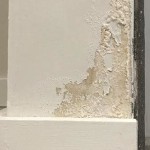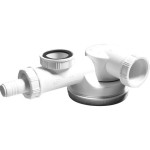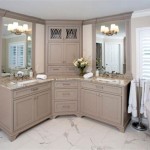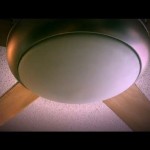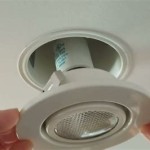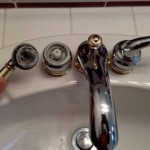```html
Cleaning Bathroom Mould with Bleach: A Comprehensive Guide
Bathrooms, by their very nature, are prone to moisture. Showers, baths, and even handwashing contribute to a humid environment that fosters the growth of mould. Mould, a type of fungus, not only presents an unsightly appearance on surfaces but can also pose health risks, particularly for individuals with allergies or respiratory sensitivities. While various cleaning agents are available, bleach remains a commonly used solution for tackling bathroom mould. This article provides a detailed examination of using bleach to clean mould in bathrooms, covering its effectiveness, associated risks, safety precautions, and alternative strategies.
Understanding Mould and Its Hazards
Mould thrives in damp, poorly ventilated areas. It reproduces through tiny spores that float in the air and settle on surfaces. When these spores encounter moisture and a suitable organic material, such as soap scum, drywall, or grout, they begin to grow and form visible colonies. Mould growth is often characterized by discolouration, typically ranging from black and green to white and brown. Common locations for mould growth in bathrooms include shower walls, grout lines, ceilings, around sinks, and underneath leaky fixtures.
The health risks associated with mould exposure vary depending on the type of mould and the individual's sensitivity. Symptoms can range from mild allergic reactions, such as sneezing, coughing, and itchy eyes, to more severe respiratory problems like asthma attacks. Prolonged exposure to certain types of mould can also lead to more serious health complications. Therefore, addressing mould infestations promptly and effectively is crucial for maintaining a healthy indoor environment.
Before employing any cleaning method, it is paramount to identify the extent of the mould infestation. Small, isolated patches of mould can often be managed with DIY solutions. However, large or widespread mould growth, particularly if it covers an area larger than 10 square feet, may necessitate professional mould remediation services. Professional services possess the equipment and expertise to safely and effectively remove extensive mould infestations and address the underlying moisture issues that contribute to their recurrence.
Bleach as a Mould Cleaning Agent: Effectiveness and Limitations
Bleach, specifically sodium hypochlorite, is a powerful oxidizing agent that can effectively kill mould on non-porous surfaces. It works by disrupting the cellular structure of the mould, leading to its eradication. When applied to surfaces like tiles, glass, and sealed grout, bleach can quickly eliminate visible mould growth. However, the effectiveness of bleach is limited on porous materials such as drywall, wood, and fabric.
Porous materials allow mould to penetrate beneath the surface. While bleach may kill the mould on the surface, the underlying roots remain intact. Consequently, the mould is likely to reappear after a period of time. In these instances, bleach may only provide a temporary cosmetic solution without addressing the root cause of the problem. Moreover, bleach can damage certain materials, causing discoloration, weakening, or even complete degradation. It is, therefore, imperative to assess the surface material before applying bleach and to test the solution on an inconspicuous area first to check for adverse reactions.
Furthermore, bleach can react with other cleaning agents, such as ammonia, to produce toxic and potentially lethal fumes. Mixing bleach with ammonia or other acidic cleaners should be strictly avoided. The resulting gases can cause severe respiratory irritation, chemical burns, and even death. Always ensure adequate ventilation when using bleach and never mix it with any other cleaning products.
Safety Precautions When Using Bleach to Clean Mould
The use of bleach mandates adherence to stringent safety precautions to minimize potential health risks. Proper ventilation is the first and foremost consideration. Opening windows and doors or using an exhaust fan can help to dissipate the fumes and prevent them from accumulating in the confined space of the bathroom. Cross-ventilation is particularly important, as it facilitates the movement of air and encourages the removal of airborne irritants.
Personal protective equipment (PPE) is essential to safeguard against skin and eye irritation. Wearing gloves, a mask, and eye protection, such as goggles, can prevent direct contact with the bleach solution and protect against inhalation of fumes. The gloves should be made of a chemical-resistant material, such as nitrile or rubber, to prevent the bleach from penetrating the skin. The mask should be an N95 respirator to filter out airborne mould spores and bleach particles.
When preparing the bleach solution, it is generally recommended to use a diluted solution of one part bleach to ten parts water. Using a stronger concentration does not necessarily increase its effectiveness and can actually increase the risk of damage to surfaces and health complications. Always add bleach to water, never the other way around, to prevent splashing and potential chemical reactions. After applying the bleach solution, allow it to sit on the affected surface for approximately 10-15 minutes to allow it to effectively kill the mould. Then, thoroughly rinse the area with clean water and dry it completely.
Following the cleaning process, it is crucial to properly dispose of any contaminated materials, such as sponges, cloths, and disposable brushes. Place these items in a sealed plastic bag and dispose of them in accordance with local regulations. Wash any reusable cleaning tools thoroughly with soap and water to prevent the spread of mould spores. It is important to note that bleach is corrosive and can damage metal surfaces. Avoid using bleach on sensitive metals or ensure thorough rinsing and drying after application.
Alternative Mould Cleaning Solutions
While bleach can be effective in cleaning mould, several alternative solutions offer a safer and, in some cases, more effective approach, particularly for porous materials. White vinegar, for instance, is a mild acid that can kill approximately 82% of mould species. It is also less toxic than bleach and does not emit harmful fumes. To use white vinegar, simply spray it directly onto the mouldy surface, let it sit for an hour, and then wipe it clean with a damp cloth. Baking soda is another natural cleaning agent that can effectively remove mould and deodorize the affected area. To use baking soda, create a paste by mixing it with water and apply it to the mouldy surface. Let it dry, and then scrub it off with a brush.
Hydrogen peroxide (3%) is another readily available solution that can kill mould. Spray the hydrogen peroxide onto the mouldy surface, let it sit for 10-15 minutes, and then scrub it clean. Tea tree oil is a natural antifungal agent that can be used to kill mould. Mix a few drops of tea tree oil with water in a spray bottle and spray the solution onto the mouldy surface. Do not rinse; allow the tea tree oil to air dry. Borax is a natural mineral that can be used to kill mould and prevent its regrowth. Mix borax with water to create a solution and apply it to the mouldy surface. Scrub the area clean and wipe away any excess solution.
Commercial mould removal products are also available. These products are specifically formulated to kill mould and prevent its recurrence. When using commercial mould removal products, it is essential to follow the manufacturer's instructions carefully and to wear appropriate personal protective equipment. Enzyme-based cleaners are also an option. These cleaners break down the organic matter that mould feeds on, effectively eliminating the source of the problem. Enzyme-based cleaners are generally safe and non-toxic, making them a suitable choice for individuals with sensitivities to harsh chemicals.
Preventing Future Mould Growth
Preventing mould growth is often more effective than attempting to eliminate it after it has already taken hold. The key to preventing mould growth is to control moisture levels in the bathroom. Regular ventilation is crucial. Running the exhaust fan during and after showers and baths can help to remove excess moisture from the air. If the bathroom lacks an exhaust fan, opening a window can provide adequate ventilation.
Addressing leaks promptly is essential. Repairing leaky faucets, showerheads, and pipes can prevent the continuous supply of moisture that mould needs to thrive. Wiping down wet surfaces after showering or bathing can also help to prevent mould growth. Use a squeegee or towel to remove excess water from shower walls, doors, and floors. Maintaining a clean bathroom environment can help to prevent mould growth. Regularly cleaning soap scum, hair, and other organic debris can reduce the amount of nutrients available for mould to feed on.
Consider using mould-resistant paint in the bathroom. Mould-resistant paints contain additives that inhibit mould growth. These paints can be particularly helpful in preventing mould growth on walls and ceilings. Dehumidifiers can be used to reduce humidity levels in the bathroom, particularly in humid climates. Maintaining a humidity level below 60% can significantly inhibit mould growth. Regularly inspecting the bathroom for signs of mould growth can help to identify and address problems early before they become more severe. Pay particular attention to areas that are prone to moisture, such as shower walls, grout lines, and around sinks.
```
Black Mould Get Rid Of With Bleach And Toilet Roll Express Co

Oxiclean Bleach Mold Mildew Stain Remover

Woman Transforms Bathroom With Sdy Cleaning Daily Mail

Clorox Mold Mildew Remover With Bleach Malaysia

This Easy Will Remove Black Mould From Any Bathroom Better Homes And Gardens

Cleaning Bathroom Mold With Bleach Effectively Lovetoknow

How To Get Rid Of Mold In The Shower On Bathroom Walls Clorox

Black Mold In The Shower How To Clean It Kitchen With Matt

Black Mold In The Shower How To Clean It Kitchen With Matt

Lysol Bathroom Bleach Mold Mildew Cleaner Trigger Spray 950ml X 12 Bottles Case
Related Posts
